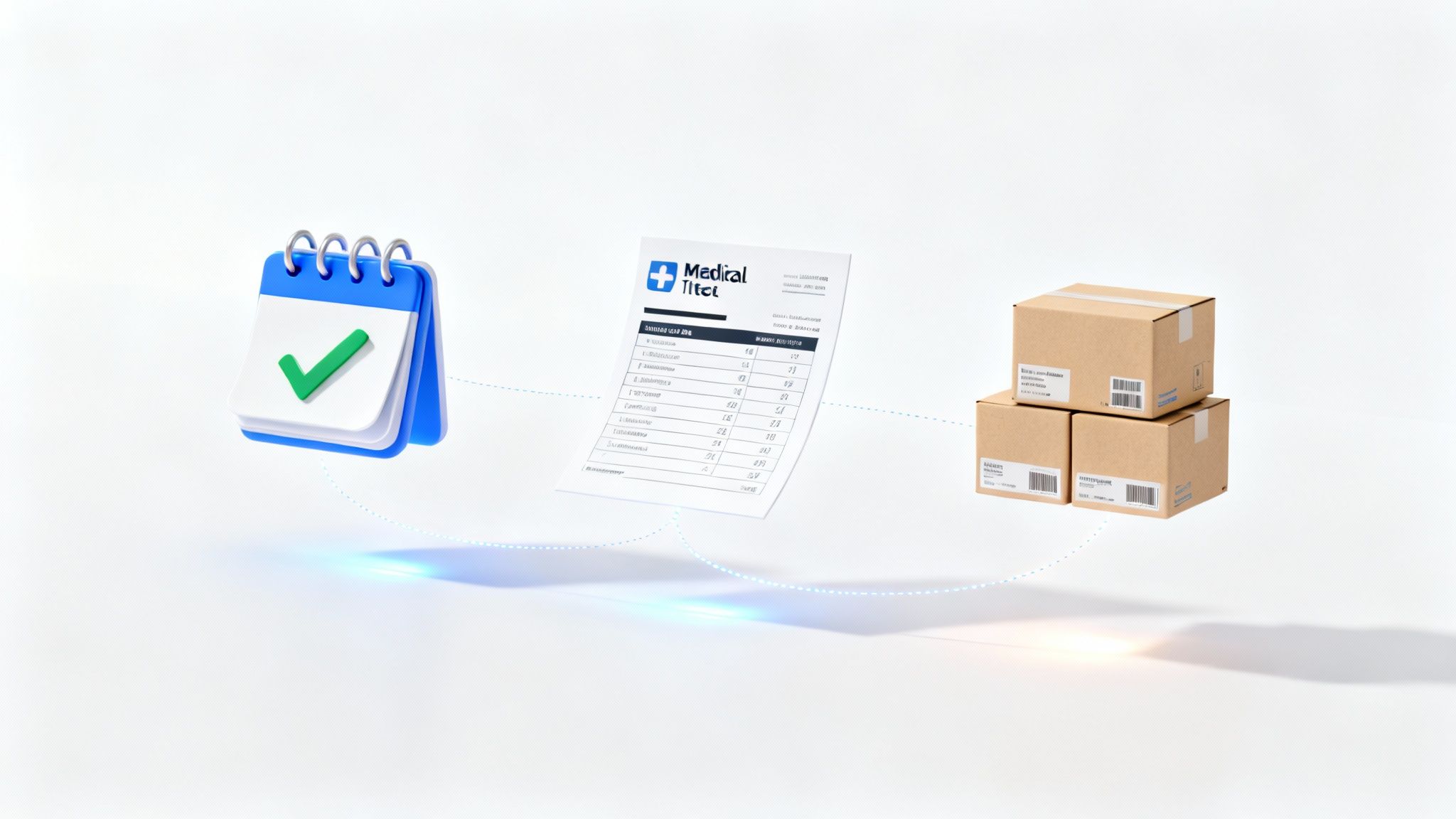Let's cut through the jargon for a second. When we talk about healthcare business process automation, don't picture robots roaming the halls. Instead, think of it as the digital nervous system for your clinic or hospital. It intelligently connects all the moving parts of your operation—from the moment a patient books an appointment to the final insurance payment—into one cohesive, automated workflow.
The whole point is to use technology to take over the repetitive, manual tasks that bog your team down. This frees up your skilled professionals to focus on what they do best: providing exceptional patient care. Automation isn't just a technical upgrade; it's a strategic move to build a more resilient, efficient, and patient-centric healthcare organization. By streamlining the administrative side of medicine, you create an environment where clinicians can thrive and patients receive the seamless experience they expect.
What Healthcare Business Process Automation Really Means

Imagine a bustling hospital is like a complex orchestra. You have different sections—scheduling, billing, clinical teams, the pharmacy—and each one plays a crucial role. Without a conductor, the performance can quickly become chaotic. Relying on manual processes is like the musicians passing handwritten notes back and forth; it’s slow, prone to mistakes, and just plain clunky. In this analogy, miscommunication doesn't just lead to a bad performance; it can lead to delayed care, billing errors, and frustrated patients.
Healthcare business process automation is that conductor. It makes sure every section is perfectly in sync by automating the flow of information and tasks. We're not just talking about replacing one person's job with a machine; we're talking about redesigning entire workflows to be smarter, faster, and more efficient from the ground up. This involves leveraging technologies like robotic process automation (RPA), artificial intelligence (AI), and machine learning (ML) to handle rule-based and even some decision-based tasks that traditionally consume significant human effort.
The Core Idea Behind Automation
At its heart, automation is about taking the predictable, rule-based tasks off the shoulders of highly trained healthcare professionals. These are the jobs that eat up so much time but don't require deep clinical judgment or human empathy. The goal is to liberate your most valuable assets—your people—from administrative drudgery so they can apply their skills where they matter most.
Think about all the common bottlenecks that drive everyone crazy:
- Manually typing patient data from paper forms into the Electronic Health Record (EHR).
- Spending hours on the phone with insurance companies to verify a patient's coverage.
- Sending out appointment reminders one by one.
- Chasing down missing paperwork to get a billing claim processed.
- Sorting and routing faxes and digital documents to the correct patient charts.
These are the exact kinds of administrative headaches where automation truly excels. It creates smooth, seamless processes that drastically cut down on human error and eliminate those frustrating delays for both staff and patients. It transforms fragmented, siloed operations into a connected, efficient ecosystem.
This isn't just a future concept; it's happening now. A staggering 86% of healthcare organizations are already using AI to automate different processes, a shift fueled by the massive need for better efficiency. Just look at Banner Health, a system that saved an estimated 1.2 million hours of work by automating the migration of medical records. That's real time given back to focus on what matters. You can find more insights on AI's role in healthcare efficiency and see the impact for yourself.
Key Takeaway: Automation isn’t about replacing people in healthcare. It's about getting rid of the tedious administrative friction that prevents your team from delivering the best possible care.
By letting technology handle the operational background noise, you empower your staff to give their full attention to patients, which leads to better outcomes and, frankly, a much happier team. It's about optimizing the entire system for quality, not just speed.
Why Automation Is a Game-Changer for Healthcare

Let's look beyond the buzzwords. At its core, healthcare business process automation isn't just about making things faster—it's about fundamentally changing how your organization operates for the better. The real magic happens when you see improvements across both the financial and clinical sides of your practice, creating a ripple effect that touches everyone from the back office to the examination room.
When the administrative side of healthcare runs smoothly, the entire system just works better. It's a simple equation: less time buried in paperwork means more time dedicated to patient care. And that’s the whole point, isn't it? This shift from clerical tasks to clinical focus is where you start to see the true value of automation shine through. It’s not an IT project; it’s a clinical quality and business health initiative.
Boosting Your Bottom Line and Reducing Errors
The financial health of any practice is tightly linked to how efficiently it runs. We all know that manual billing and claims processing are breeding grounds for expensive mistakes—think incorrect patient data or mismatched procedure codes. These small errors often snowball into claim denials, which stalls your revenue and forces your staff to spend hours on frustrating rework. A single typo can delay a payment by weeks, impacting cash flow and adding unnecessary costs.
Automation tackles this problem head-on. Imagine a system that automatically checks data for accuracy and flags problems before a claim even goes out the door. For instance, it can verify a patient's insurance eligibility instantly, eliminating one of the most common reasons for rejection. It can cross-reference procedure codes with patient records to ensure consistency. This doesn't just get you paid faster; it makes your entire revenue cycle more reliable and predictable.
Think about the impact on patient safety. Medication errors, a huge risk in any clinical setting, can be drastically cut down. In fact, studies show that integrating automated systems can reduce medication errors by as much as 54%, which means safer care and lower liability.
Giving Time Back to Clinical Staff
One of the biggest wins with automation is its power to fight staff burnout. Your doctors and nurses are often drowning in administrative tasks that have nothing to do with their actual jobs. This constant administrative drag is a massive source of stress and a key reason why great people leave the profession. The "pajama time" spent catching up on EHR notes after hours is a well-known symptom of this systemic problem.
When you automate routine work like scheduling appointments, sending out reminders, or handling prescription refills, you’re essentially giving those jobs to a tireless digital assistant. The impact of this one change is huge:
- More Patient Face Time: Clinicians can finally put their full attention where it belongs—on diagnosing, treating, and connecting with their patients. This enhances the quality of care and strengthens the patient-provider relationship.
- Reduced Mental Strain: Taking mundane tasks off their plate frees up mental energy for the complex clinical decisions that only a human expert can make. This is crucial for preventing cognitive fatigue and improving diagnostic accuracy.
- A Better Work-Life Balance: An efficient workflow means less time spent after hours catching up on paperwork, leading to a happier and more sustainable team. This directly combats burnout and improves staff retention.
In the end, automation isn't just some tech upgrade; it's a strategy for building a stronger, more resilient healthcare operation. It directly connects a healthier bottom line with better patient outcomes, making it an essential tool for any modern practice.
Key Healthcare Processes Ready for Automation

So, where do you start with healthcare business process automation? The smartest move is to find the tasks that are repetitive, follow clear rules, and eat up a ton of your staff's time. Think of it as finding the biggest administrative headaches—the points of friction that cause delays and frustration. These low-hanging fruits offer the quickest path to demonstrating value.
By tackling these high-impact areas first, you'll see a real difference, fast. This not only makes a strong case for automation but also gets your team excited about what's possible. Let's look at a few places where automation is already making waves.
Patient Scheduling and Appointment Reminders
We've all seen it: front desk staff are buried in phone calls, trying to schedule appointments, move things around, and chase down patients for reminders. It's a never-ending cycle, and even with all that effort, no-shows still happen, leaving expensive gaps in the calendar. Each missed appointment is lost revenue and a missed opportunity for care.
Now, imagine a different way. An automated system lets patients book or change their appointments online whenever it suits them, even at 2 AM. The system then automatically sends out reminders via text or email, which is proven to slash no-show rates. Suddenly, your front desk team isn't just answering phones—they're free to give their full attention to the patients standing right in front of them, improving the in-person experience.
Medical Billing and Claims Processing
Manual billing is a minefield. One tiny mistake—a typo, the wrong code—and a claim gets rejected. This kicks off a frustrating back-and-forth with the insurance company, holding up payments and draining resources. The complexity of coding and payer-specific rules makes human error almost inevitable.
Automation completely changes this game. Smart software can:
- Instantly check a patient's insurance eligibility before they even walk in the door.
- "Scrub" claims for common errors before they're ever sent, checking them against payer rules.
- Handle the entire submission process and keep an eye on claim status, only flagging the team when a human needs to step in.
This gets you paid faster and takes a huge administrative weight off your billing department. A big part of this shift is powered by tools like voice recognition software designed for healthcare, which helps capture accurate information right from the start.
Prior Authorization Management
Ask anyone in a clinic, and they'll tell you prior authorizations are a major source of pain. The paperwork, the phone calls, the waiting—it all adds up to delays in patient care and serious staff burnout. It's a process that is universally disliked by providers and patients alike.
This is where automation can be a real hero. AI-powered tools can take over the grind of submitting requests and checking on their status. They connect directly with the EMR to pull the right clinical notes and handle the communication with payers, turning a week-long headache into a much smoother, often minutes-long process. Want to see how it works? You can check out our guide on AI for prior authorization at https://www.simbie.ai/ai-prior-authorization/.
Supply Chain and Inventory Management
Running out of gauze or a specific medication just isn't an option in healthcare. But relying on manual counts and spreadsheets often leads to exactly that—or the opposite problem of over-ordering and wasting money. Inaccurate inventory data can jeopardize patient care and strain budgets.
An automated system keeps a live count of everything in your stockroom. As soon as a supply drops below a certain level, it can automatically create a purchase order. This simple change ensures you never run out of what you need, cuts down on tedious manual work, and helps control costs by avoiding those expensive, last-minute rush orders.
To see the big picture, let's compare how automation transforms different parts of a healthcare organization.
Impact of Automation Across Healthcare Departments
The table below shows a side-by-side look at the common struggles with manual work versus the tangible benefits that automation brings to the table.
| Department/Process | Manual Process Challenges | Automation Solution & Benefits |
|---|---|---|
| Patient Scheduling | High call volume, frequent no-shows, staff tied to phones, limited booking hours. | Online portals and automated reminders cut no-shows, free up staff for in-person care, and allow 24/7 booking. |
| Medical Billing | Prone to human error, slow claim submissions, delayed payments, high denial rates. | AI-powered claim scrubbing and automated submissions reduce errors by 90%, accelerate revenue cycles, and lower administrative costs. |
| Prior Authorizations | Time-consuming paperwork, long wait times for approvals, delays in patient treatment. | Intelligent automation pulls data from EMRs, submits requests, and tracks status, significantly speeding up approvals and reducing staff burden. |
| Inventory Management | Risk of stockouts or overstocking, manual counting is tedious and inaccurate, rush orders increase costs. | Real-time tracking and automated reordering ensure optimal stock levels, prevent waste, and provide clear visibility into supply usage. |
As you can see, the impact isn't just about saving a few minutes here and there. It’s about creating a more reliable, efficient, and patient-focused operation across the board.
Your Roadmap to a Successful Automation Rollout
Bringing automation into your healthcare organization doesn’t have to feel like a massive, overwhelming project. A thoughtful plan makes all the difference. Think of it less as a giant technological overhaul and more as a series of smart, targeted upgrades that build on each other for a big impact. A strategic, phased approach is key to managing change and ensuring success.
The journey starts by picking the right battles. You don't need to automate everything at once. In fact, trying to do that is a surefire way to get frustrated. Instead, look for the quick wins—those high-volume, repetitive tasks that follow a clear set of rules. These are the perfect places to start.
Pinpoint Your Starting Line
Before you can automate any process, you have to know it inside and out. A crucial first step is to really understand and visualize your current workflows, and a great way to do that is by learning how to create process maps. This exercise helps you see every single touchpoint, delay, and manual step. It brings stakeholders from different departments together to create a shared understanding of how work actually gets done.
Once you have that clear picture, focus on the areas that will give you the fastest return on your effort. Good candidates include:
- Patient Intake: Automating how you collect demographic and insurance information.
- Appointment Reminders: Sending out automated texts or emails to cut down on no-shows.
- Initial Claims Submission: Using software to double-check for common errors before claims are sent out.
Starting small lets you prove the value quickly, build momentum, and get your team comfortable with the new way of doing things. This success builds the business case for expanding automation to more complex areas.
Choose the Right Technology Partner
Picking the right partner is just as critical as picking the right process. Not all automation vendors are the same, especially when you're dealing with the highly regulated world of healthcare. Your evaluation needs to be thorough and focused on a few key non-negotiables. A vendor should be more than a technology provider; they should be a strategic advisor.
Your technology partner should feel like an extension of your team, not just someone selling you software. Their deep understanding of healthcare challenges is what makes an implementation successful and compliant.
When you're looking at potential vendors, make these factors your priority:
- HIPAA Compliance and Security: This is table stakes. The vendor absolutely must have rock-solid security protocols and a proven history of protecting patient data. Ask for their compliance certifications and security audit reports.
- Seamless EMR Integration: The new tool has to play nicely with your existing Electronic Medical Record system. Clunky integration just creates more manual work, which completely defeats the purpose. Digging into different EMR system integration approaches is a must.
- Scalability: Go with a solution that can grow with your practice. The platform should be able to take on more complex processes as your needs change over time.
- User Experience (UX): The tool must be intuitive and easy for your staff to use. A complicated interface will lead to low adoption rates, undermining the entire project.
Empower Your People Through Change
Finally, never forget that healthcare business process automation is ultimately about people. The technology is a tool meant to empower your team, not replace them. Frame automation as a kind of digital assistant that takes care of the tedious stuff. This frees up your staff to focus on more meaningful, patient-facing work.
Good communication and training are key here. Involve your staff from the beginning of the selection and implementation process. Show your team exactly how these new tools will make their jobs easier and help reduce burnout. When your staff starts to see automation as a helpful ally, adoption becomes a much smoother, more collaborative effort. That’s how you ensure the project delivers on its promise to improve both how you operate and the care you provide.
Navigating Common Hurdles in Healthcare Automation
While the promise of healthcare business process automation is huge, let's be realistic—the road to getting there isn't always perfectly smooth. Like any big technology shift, it comes with its own set of challenges. Knowing what to expect is the best way to plan a rollout that actually helps your team without causing chaos.
Think of it like this: successfully bringing in automation means clearing three big hurdles. You’ve got to lock down data security, figure out how to connect new tools with your old systems, and convince leadership that it's a worthy investment. If you tackle these head-on, what looks like an obstacle can become a real strength.
Upholding Data Security and HIPAA Compliance
In healthcare, patient data is everything. Protecting it isn't just a good idea; it's the law. So, it's completely understandable to feel a bit hesitant about handing sensitive information over to an automated system. A data breach is a nightmare scenario, which is why security has to be your number one priority from day one.
This means any automation partner you even consider must live and breathe HIPAA standards. We're not talking about a simple checkbox on a feature list. We're talking about ironclad security measures baked into the very foundation of their technology. This includes a willingness to sign a Business Associate Agreement (BAA).
When you're vetting potential tools, look for these non-negotiables:
- End-to-end encryption that shields data whether it's being sent or just sitting on a server.
- Detailed audit trails that create a clear record of every single action, so you always know who did what and when.
- Role-based access controls that smartly limit what staff can see, ensuring they only access information essential for their job.
Choosing the right platform is absolutely critical for keeping patient trust and staying on the right side of regulators. For a deeper dive, check out our guide to HIPAA-compliant AI tools to get a better sense of what a truly secure platform looks like.
An automation tool should make your compliance stronger, not introduce new risks. By reducing manual data handling and creating perfect audit logs, the right system can actually cut down on human error and prevent unauthorized access.
Integrating with Legacy Systems
Most healthcare organizations are a patchwork of different systems—some new, some… not so new. Those older, legacy platforms, like your main EHR, are the backbone of your daily operations. The real trick is getting a new automation tool to play nice with these existing systems without breaking your workflow or creating isolated pockets of data.
A clunky integration completely defeats the purpose of automation. If your team has to resort to manual workarounds and copy-pasting data, you haven't solved anything. The key is to find solutions built with interoperability in mind. A good technology partner will have a proven track record of successful integrations, using standard protocols like HL7 and FHIR to ensure information flows freely between their platform and your core systems. This keeps everyone working from a single source of truth and avoids frustrating data jams.
Building the Business Case for Automation
Finally, you need to get leadership on board. This means building a rock-solid business case that clearly shows the return on investment (ROI). And it's not just about the money. You need to connect the dots between the investment and solving real-world problems that keep executives up at night.
Frame the conversation around the big-picture benefits. Explain how automation can directly address pressing issues like staff burnout, costly billing errors, and long administrative delays that affect patient satisfaction scores. Use data from your process mapping exercise to quantify the time and money lost to inefficiency. When you show how it improves both the bottom line and the day-to-day work environment, you're much more likely to get the green light.
The Future of Intelligent Automation in Healthcare

So far, we've talked about automating the tasks we do today. But what about tomorrow? The next big leap in healthcare business process automation is adding a brain to the operation—infusing standard automation with artificial intelligence (AI) and machine learning (ML). This is where things get really interesting. This is the shift from "robotic" process automation to "intelligent" automation.
Think beyond just having a robot that checks boxes. Imagine systems that can learn from data, spot patterns, and suggest what to do next. These systems can understand unstructured data like clinician notes, faxes, and patient emails. This upgrade turns automation from a simple rule-follower into a smart partner for clinicians. It’s the difference between a simple calculator and a savvy financial advisor.
This isn’t some sci-fi fantasy; it’s the natural next step. When you combine the consistency of automation with the smarts of AI, healthcare organizations can reach a whole new level of efficiency and patient care.
From Doing to Thinking: The Rise of Predictive Healthcare
The most exciting part of this shift is the move toward predictive analytics. Instead of just reacting to problems as they happen, intelligent automation will help providers get out in front of them. We're talking about shifting from a reactive "sick care" model to a genuinely proactive one.
For example, what if a hospital system could accurately predict a spike in admissions during flu season? By digging into past data and current community health trends, an intelligent system could automatically suggest changes to staffing schedules or trigger orders for more supplies. This foresight prevents overcrowding and ensures everyone gets the care they need, right when they need it.
The real goal here is to answer critical questions before anyone even thinks to ask them. It's about building a healthcare system that anticipates needs—from a single patient all the way up to the entire community.
This forward-thinking approach will touch nearly every corner of healthcare:
- Personalized Treatment Plans: AI algorithms can sift through mountains of data to pinpoint which treatments work best for patients with specific genetic profiles or lifestyles.
- Proactive Supply Chain Management: Systems can foresee shortages of critical medications based on global trends or local demand, letting hospitals order ahead of time.
- Early Disease Detection: Machine learning can scan patient histories for subtle clues that might signal the start of a chronic illness, flagging at-risk people for early intervention.
- Operational Efficiency: AI can analyze patient flow through a hospital, identifying bottlenecks and suggesting process improvements to reduce wait times and improve resource allocation.
Ultimately, this smarter healthcare business process automation lets professionals do what they do best. With intelligent tools handling the heavy lifting of data analysis and forecasting, clinicians can focus their expertise on the complex diagnoses and compassionate care that no machine can ever replicate.
Got Questions About Healthcare Automation? We've Got Answers.
Even when you see the potential, jumping into something like healthcare business process automation can feel like a big step. It’s natural to have questions. Let's tackle some of the most common ones that come up so you can feel confident about what this technology really means for your practice.
We'll clear the air on everything from job security and data privacy to what kind of value you can realistically expect to see.
Will Automation Take Away Our Jobs?
Not at all. The real goal of healthcare automation isn't to replace your team, but to supercharge their abilities. Think of it as a tool that takes over the tedious, repetitive tasks that nobody really enjoys anyway—things like data entry, appointment scheduling, and routine billing. It's about augmenting human capabilities, not replacing human workers.
This frees up your doctors, nurses, and administrative staff to focus on what truly matters: the work that requires a human touch. We're talking about direct patient care, complex problem-solving, and strategic thinking. It’s less about replacing people and more about giving every employee a digital assistant to handle the grunt work, allowing them to work at the top of their license.
The point is to shift your team's valuable time away from monotonous paperwork and back to meaningful patient interactions. That's a win for both staff morale and patient care.
How Can We Trust Automation with Sensitive Patient Data?
This is a big one, and rightly so. Any reputable automation platform built for healthcare has security baked in from the very beginning. They operate in highly secure environments, use powerful encryption to protect data, and keep detailed logs of every single action taken. This actually makes it easier to track activity and stay compliant.
In many ways, automation can boost security. By minimizing the number of people who manually handle sensitive information, you naturally reduce the risk of human error or a potential breach. The key is to partner with a vendor who lives and breathes healthcare and can prove their platform is built to meet strict HIPAA standards. Always ensure they will sign a Business Associate Agreement (BAA) and can provide detailed information on their security architecture.
What's the Real Return on Investment Here?
The ROI from automation is substantial, and it shows up in a few different ways:
- Financial Gains: You'll see direct cost savings from less manual work, a sharp drop in billing errors, and much faster processing of insurance claims. This improves cash flow and reduces the cost to collect.
- Operational Boost: Work just flows better. You'll notice quicker turnaround times for tasks like prior authorizations and an increased capacity to manage more work without needing to hire more people. This leads to higher throughput and operational scale.
- Better Clinical Outcomes: This is where it gets really powerful. When your staff has more time to focus on patients, satisfaction goes up and health outcomes improve. Reducing administrative delays means patients get the care they need sooner.
- Improved Staff Satisfaction: By reducing burnout and removing frustrating tasks, automation leads to higher staff morale and lower turnover, which is a significant cost saving in itself.
While every practice is different, most organizations start seeing a positive return on their investment within 12 to 18 months. The key is to start with a clear use case and measure the impact from day one.
Ready to see how intelligent automation can slash administrative costs and give your staff the freedom to focus on what they do best? Discover how Simbie AI uses voice-based AI to handle scheduling, patient intake, and more, 24/7. Learn more at Simbie AI.

